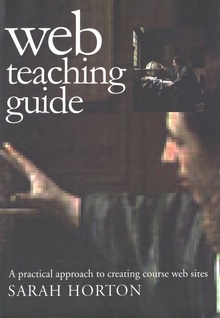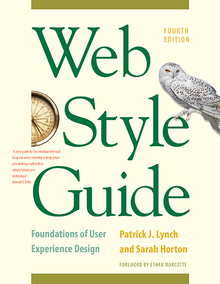Web Teaching Guide
WARNING
You are viewing an older version of the Yalebooks website. Please visit out new website with more updated information and a better user experience: https://www.yalebooks.com
A Practical Approach to Creating Course Web Sites
Sarah Horton
Prompted by student enthusiasm and by the opportunity to enhance college courses, more and more faculty members in higher education are incorporating the Web into their teaching. This helpful book is designed to answer the questions an educator who lacks extensive technical experience asks about creating a Web site: Why should I use the Web? How can the Web enhance my teaching? How do I make a Web site? How can I make it effective?
Multimedia specialist Sarah Horton draws on extensive experience as a faculty Web consultant to explain the entire process of creating a site, from initial planning through site assessment. She examines the strengths of the Web and its many possible uses. More than just a way to distribute course handouts, a Web site can provide richer content, multiple expressions of an idea, interactivity, opportunities for collaboration and customization, and flexibility for updates. Horton urges teachers to consider the ever-growing possibilities that information technology presents. Her focus is on practical matters related to creating Web-based instructional materials. With case studies throughout, she discusses the planning process, content creation, site development, and finally site implementation in the curriculum.
Multimedia specialist Sarah Horton draws on extensive experience as a faculty Web consultant to explain the entire process of creating a site, from initial planning through site assessment. She examines the strengths of the Web and its many possible uses. More than just a way to distribute course handouts, a Web site can provide richer content, multiple expressions of an idea, interactivity, opportunities for collaboration and customization, and flexibility for updates. Horton urges teachers to consider the ever-growing possibilities that information technology presents. Her focus is on practical matters related to creating Web-based instructional materials. With case studies throughout, she discusses the planning process, content creation, site development, and finally site implementation in the curriculum.
Sarah Horton is a multimedia applications specialist at Dartmouth College and the coauthor, with Patrick J. Lynch, of Web Style Guide: Basic Design Principles for Creating Web Sites, published by Yale University Press.
Visit http://www.webteachingguide.com for more information about course Web site design, including site templates, discussion forums, and resource links.
“A clear and practical yet sophisticated how-to-guide for developing a web site as a supplemental resource for a traditional ‘face-to-face’ academic course. . . . University professors, high school teachers, and library information specialists who are planning to erect a web site will benefit from Horton’s guidance on the selection and use of various types of online resources, search engines, navigation and search features, uses and abuses of audio and video, digitization of print material in various formats, use of chat rooms, compression and downloading of text and images, and many related topics. . . . Recommended.”—Tom Greives, Art Documentation
“Whether the reader simply wants to put existing course materials online . . . or has a more ambitious educational endeavor in mind—providing video clips and forums for student discussion, for example—the Web Teaching Guide offers a road map. . . . Throughout, the guide is peppered with photographs of Web sites, sample administrative materials, like a letter to a copyright holder, and interviews with professors who have created sites themselves—which give this very detailed manual a user-friendly feel.”—Elizabeth Greene, Chronicle of Higher Education
“High school and university educators about to put their courses online would do well to invest in Sarah Horton’s Web Teaching Guide.”—Communication Arts
“A thorough, practical approach to preparing and using a Web site as an enhancement to fact-to-face classroom meetings. . . . For those about to embark on this particular journey, following her sound advice will prove valuable.”—Educause Quarterly
“These two books contain valuable guidance for Web designers. Buy them. . . . Essential reading.”—Tom Wilson, Information Research
"Horton has written one of the best books I have ever seen on the overall process of web site design without getting bogged down in the details of HTML coding. Web Teaching Guide provides an excellent process overview for academic web site design."—Lee Honeycutt, Iowa State University
“Horton . . . has written a time-saving, illustrated guide that instructs teachers and facilitators how to put course content on the web. Horton’s intelligent and succinct presentation enables teachers to tailor their approach and gradually add other material when reorganizing, updating and expanding. . . . Teacher’s colleges can also utilize this work for touching on the pedagogical effectiveness of instructional technology. Best of all, educators can use the web without reading about its history, current developments, or future prospects. . . . Recommending for most academic libraries.”—Library Journal
“This guide is useful and appropriate for any instructor desiring to connect students to one another and to resources around the world. . . . [A]n invaluable guide to instructors wishing to explore the benefits of school websites.”—Penny Hayne, Media and Methods
“An excellent, concise, and accessible guide to the central design principles involved in developing Web sites to support classroom-based teaching and learning. . . . It is a good general introduction to the Web as a resource for teaching . . . [and] and excellent resource for people who are fluent users of the Web.”—Mary E. Hess, Teaching Theology
“[Horton] offers valuable and practical advice in a language and context that her audience will understand. . . . This is a valuable guide, and I would recommend it to anyone interested in developing web-based teaching materials. Its readable style and constructive advice make it useful to those managing and delivering web-based teaching—whether as a minor supplement to conventional teaching or as a fully fledged distance-teaching resource.”—Jo Wood, Times Higher Education Supplement
“This is an original, concise, and practical approach to the subject of Web design and implementation for university faculty.”—Laura J. Gurak, University of Minnesota
Winner of the 2000 PSP Award in the Computer Science category given by the Professional/Scholarly Publishing Division of the Association of American Publishers
ISBN: 9780300087277
Publication Date: October 11, 2000
Publication Date: October 11, 2000
256 pages, 7 1/2 x 9 1/4
200 b/w illus.
200 b/w illus.



